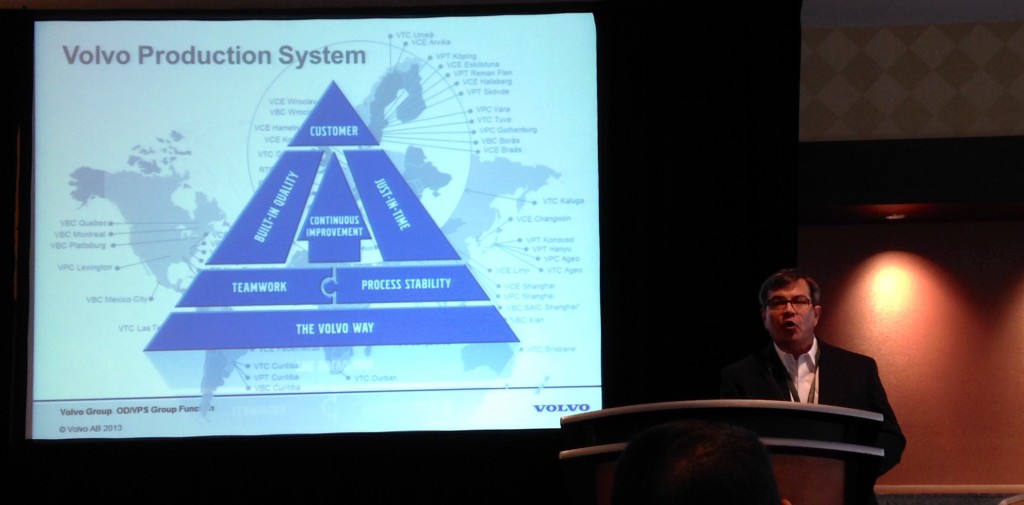Motivated by many media articles warning against JIT as the culprit for supply chain disruptions, the POMS College of Operational Excellence organized the webinar “Just-in-time or Just-in-case” in February 2022. Extending this online debate, five participants co-authored an article intending to provide advice for future research into JIT. After peer-review, the article “Just-in-time for supply chains in turbulent times” is now published open-access in Production and Operations Management.
Continue readingTag Archives: Lean
One more time: What is lean?
What is lean? After all these years, there is still confusion. Truth is, opinions on lean differ widely. If you like heated debates, start a discussion thread on the definition of lean on LinkedIn. Many subscribe stubbornly to their own definitions and claim others “don’t get it.” In an attempt to enlighten the debate, the Journal of Operations Management (JOM) has recently published two articles that address the question.

Lean and the Corona pandemic: A clarification
Due to the Corona pandemic, critical supply chain shortages have occurred. Many have looked for the problem and pointed at the Just-In-time principle of Lean as one of the evils. This calls for clarification. Lean is not to blame, but part of the solution.
Read moreTop 10 scientific papers on lean
Scientific thinking is a cornerstone of lean thinking, but the lean movement itself has unfortunately become largely unscientific. Here are ten academic lean papers you should know.
The Routledge Companion to Lean Management wins the Shingo Research Award
Terrific news! It is a great honor to receive the prestigious Shingo Research Award for the Routledge Companion to Lean Management, co-edited with Dr. Daryl Powell and published with Routledge earlier this year.
Five rules of productivity improvement
If I should explain my research in two words, I would say “improving productivity”. That was also the title of my inaugural lecture at ETH Zurich today. In the lecture, I presented five rules of productivity improvement, which I summarize in this post. The full inaugural lecture is available here (lecture starts at 7 min 30 sec):
The 3 Ls of lean management
The Routledge Companion to Lean Management has hit the book shelves. Here is a summary of its main conclusions. The key message? Any lean transformation—regardless of the sector and application area—is dependent on the three essential Ls of lean: Leadership for Long-term Learning.
Manufacturing Cost Deployment: How to select the right projects
How do firms prioritize and select improvement projects? Unfortunately, the usual method is a combination of guess and chance. Few companies are able to compute the real return on investment from proposed projects, and select the better ones through a rigorous decision process. This is not a trivial problem, but an important one: Many firms spend much money on useless improvements — fixing issues that are non-critical or have low or no effect on factory performance. In these firms, middle managers battle for the attention and investments of senior management by writing up speculative “business cases” for their proposed improvement projects. Few of these firms have heard about Manufacturing Cost Deployment — a structured method for selecting the right improvement project.
Five critical success factors for implementing lean programs
Two out of three lean programs fail to achieve their initial objectives. My latest research asked 432 practitioners from 83 factories in two multinational corporations what they see as critical factors for succeeding with lean implementation. The research summarized five critical success factors for implementing lean programs that managers must get right. Is your organization on track?
5S done right
5S. Five short Japanese words, each beginning with an “S”. The majority of employees in the industrial sector, and increasingly in the public sector, have heard about the “5Ss”. The problem? The vast majority of companies trying to “implement” 5S fails, and does so repeatedly. Many mistakes it as a concept for cleaning and tidying up—boring but necessary activities for any professional business. This post* takes a closer look at each of the five S-words, and finds that many of us might have missed the point.
Poor performance? The problem is you! (A review of Lead with respect)
“The problem is you”, is the honest response of a senior manager when a supplier’s CEO asks more time to solve a quality issue. He continues: “I don’t mean you as in the company. I mean you personally. You’re the senior manager here”…. This is the intriguing start of a business novel on lean leadership. Here is my brief review of Lead with Respect: a Novel of Lean Practice by Michael Ballé and Freddy Ballé.
Lean broadcasting: Lean in the BBC
A service you probably consume every single day is broadcasting. Can lean principles help the broadcasting industry produce better value for the audience – and do so more efficiently and more effectively than today? Admittedly, I had never thought about broadcasting as a new application area for lean, but clearly it is coming. This post looks at lean broadcasting, where the British Broadcasting Corporation (BBC) is a first mover.

Liker on Lean Leadership
Why do most firms fail in their lean transformations? Because they have not understood the power of lean leadership, says Professor Jeffrey Liker. I spent the last two days together with the Norwegian aluminum producer Hydro ASA, listening to and learning from Liker. Here is a brief reflection on the essentials of lean leadership.
Industry 4.0: What about lean?
What is Industry 4.0? Will it end the era of lean manufacturing ? Here’s an exclusive preview of an article appearing in the Lean Management Journal.
10 benefits of lean games
How can we boost the learning experience when teaching lean production? Admittedly, presentations and monologues from the front of the classroom are rarely something people remember for a long time. Learning can be greatly improved by using games and simulations, which provides the learner first-hand experience in lean and its benefits.

My own Volvo Trucks Lego Lean Game played at a MBA course in Norway
Lean culture eats national culture for lunch
Are certain national cultures better suited to implement lean thinking? In this post, I reflect on the role of national cultures in the roll-out of a corporate lean program.
The four stages of a lean transformation
This post by Professor Kasra Ferdows and myself was featured in Planet Lean (The Lean Global Network Journal) last week. It suggests that organizations that implement lean move through four distinctive stages of lean maturity—each with its own challenges and opportunities.
Factory response to a corporate lean program: The 4A model
How do factories respond when the headquarters of a multinational firm rolls out a “new” corporate lean program? In a paper in the International Journal of Operations and Production Management*, Professor Arild Aspelund and I propose that factories can respond in four generic ways; explained by the “4A model”.
Implementing the Volvo Production System in a truck plant
To follow up my previous post about the effect of implementing lean in the global Volvo Group, here’s one short story of the implementation of the Volvo Production System (VPS) in the truck assembly plant in New River Valley, Virginia, USA.

Mr. Ebly Sanchez presents the Volvo Production System at POMS Atlanta May 2014 (Photo: author).
Do Lean Programs Pay Off?
Multinational companies roll out lean programs or XPSs. The objective is to improve the operational performance of all the factories in the global network. The party killer? It is documented that about 70 % of all general change programs fail [1], and similar figures has been suggested for lean [2]. So, do lean programs really pay off?
The Concept Epicenters of Lean, TQM, Six Sigma & co
When it comes to improving production, a standard question is this one: What are the differences between Lean, Total Quality Management (TQM), Six Sigma, Agile, Quick Response Manufacturing (QRM), and all the other prescribed improvement programs? Underlying the question is a rational need to find a way to navigate through the jungle of “solutions”, and select the one(s) that fit exactly your firm. In this blog post, I suggest that considering “Concept Epicenters” might be helpful in making the right strategic choices.
Go Lean, get Green?
Good news*: your operations can reach excellence in both Lean and Green. But to hope for success you need to treat Lean and Green as interconnected strategies—not isolated projects. That tip is a key take away from the SMARTLOG seminar “Lean & Green? Yes please both” that we arranged at SINTEF in Trondheim this week. Leading academics and corporations** in Scandinavia were invited to share their latest experiences on the topic. Do Lean and Green go well together?
Factory Beauty: Does looks impact performance?
Factories are like people; they come in all shapes and looks—some more attractive than others. There is no doubt that a good looking factory is nice for workers and visitors, but does it also have a significant impact on the plant’s operational and financial performances? How much should management care about factory beauty?
Factory Fitness: What managers can learn from Athletics
This week, the 2013 IAAF World Championships in athletics is held in Moscow, Russia. If plant managers watch carefully, they might pick up a few ideas for improving their factories. A specific concept that comes to mind is the notion of Factory Fitness – proposed by Kasra Ferdows (Georgetown University) and Fritz Thurnheer (Hydro ASA) in 2011. The key take away is the following: Whereas becoming lean is right for many, becoming fit is right for all. How to become world champion depends on the event.
The rope team: Theory of Constraints
Climbing the highest mountain in Northern Europe, a few thoughts on the Theory of Constraints came to my mind. To get to Galdhøpiggen, 2469 meters above sea level, the most common route takes you over a glacier where rope teams are used for safety reasons. In his must-read book “the Goal”, Eli Goldratt (1984) uses rope teams to illustrate an efficient production system.
This is lean!
A book review of This is lean!
‘If lean is everything that is good, and everything good is lean, what is then the alternative?’ Niklas Modig and Pär Åhlström ask this timely question in their book This is lean. The authors go on to suggest what lean is, and what it is not. But, at Amazon.com there are more than 7000 books on lean, why should you read this one?
The World Class Manufacturing programme at Chrysler, Fiat & Co.
The company-specific production system (XPS) of Chrysler is the World Class Manufacturing (WCM) concept, developed by the Fiat Group in 2006. But, what exactly is the WCM? And, what does Chrysler see as keys to success in WCM?

Is Lean Six Sigma relevant for the 21st Century Manufacturing?
A report from POMS 2013 in Denver
Are Lean and Six Sigma relevant for the 21st Century Manufacturing? An answer to this—and thousand other questions—is being suggested at the annual POMS Conference in Denver, Colorado, this week.
Can ERP support the implementation of lean production?
Yesterday, my colleague Daryl Powell successfully defended his PhD thesis titled “Investigating ERP Support for Lean Production” at the Department of Production and Quality Engineering at NTNU, Trondheim, Norway. Over the last three years, Powell’s research has received much interest from the international Operations Management research community and from industrial companies struggling with the mismatch between lean production and ERP (Enterprise Resource Planning systems). Is lean production and ERP solutions for pull production mutually exclusive?
Nissan Production Way: A better alternative to TPS?
I have visited three former Nissan Diesel factories in Japan this week (today owned by a foreign multinational). The plants operate according to the Nissan Diesel Production System—a bi-product of the famous Nissan Production Way (NPW). I believe that too many lean-lovers focus too heavily on the Toyota Production System (TPS), and know too little about alternative approaches to world-class production. The core idea of an XPS is exactly that the X should be tailored to the company, and not be a TPS-blueprint. In fact, the NPW might provide a better benchmark for many Western manufacturers than the TPS…

